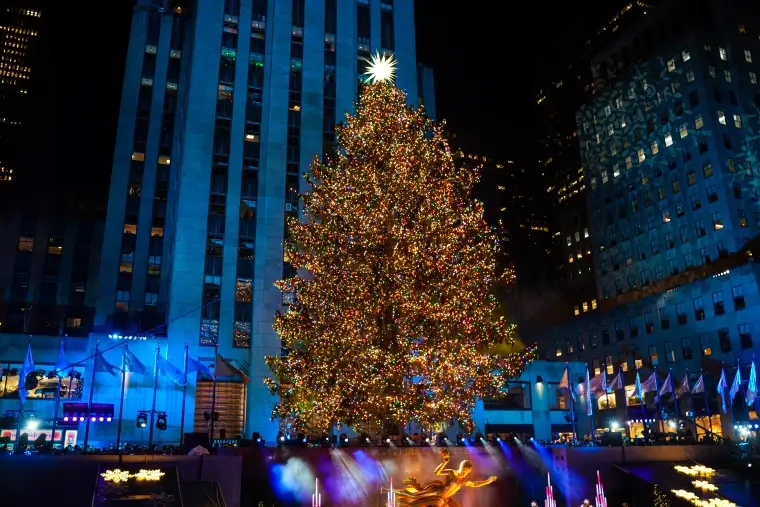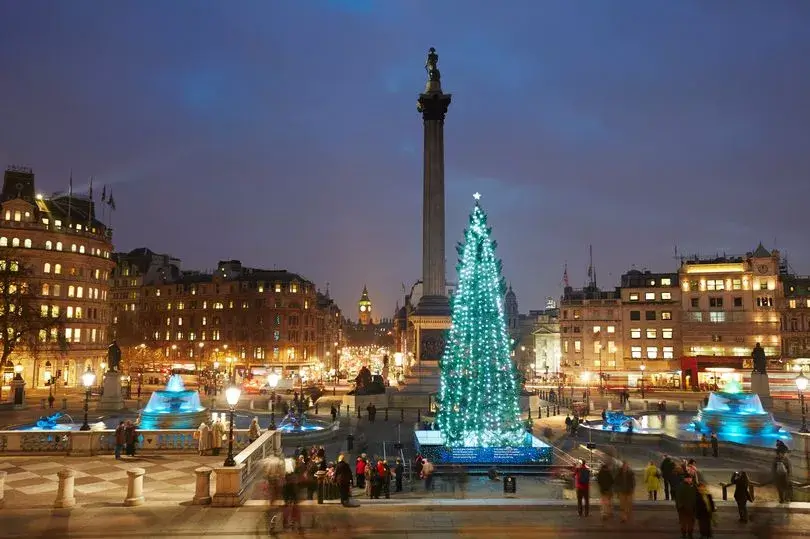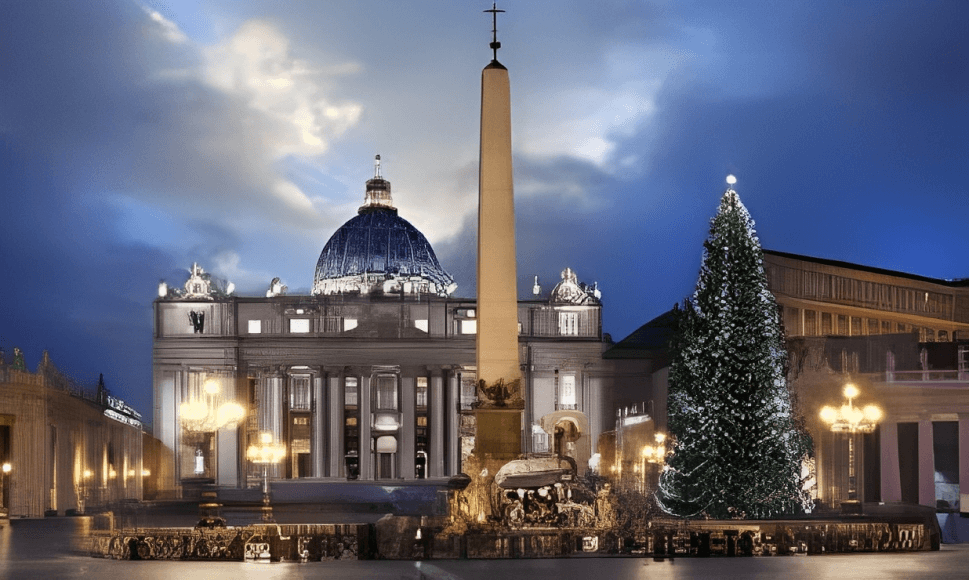
Beautiful Christmas Trees : The Christmas tree has long been an iconic and cherished symbol of the holiday season. Its vibrant ornaments, twinkling lights, and aromatic presence evoke feelings of joy, warmth, and togetherness. Every year, millions of families around the world eagerly decorate their Christmas trees, making them unique expressions of their holiday spirit and creativity. In this essay, we will explore the history, significance, and various styles of Christmas trees that have earned the distinction of being the best and most beautiful.
Christmas trees have evolved over the centuries from simple evergreens to elaborate works of art, reflecting the diverse cultures and creative spirits of those who celebrate the holiday season. Whether it’s the grandeur of the Rockefeller Center tree or the charm of a family’s hand-decorated tree, these evergreens symbolize the beauty, joy, and togetherness that define the Christmas spirit. As we continue to celebrate this cherished tradition, let us appreciate the best and most beautiful Christmas trees that brighten our homes and hearts each holiday season.
1. Historical Roots of the Christmas Tree
The tradition of the Christmas tree dates back centuries, with its origins rooted in various cultural practices. One widely accepted theory attributes the Christmas tree to 16th-century Germany, where devout Christians brought evergreen trees into their homes and adorned them with candles as a symbol of the Paradise Tree. This practice was meant to celebrate the birth of Jesus Christ.
2. The Evolution of Christmas Tree Decorations
As the tradition of the Christmas tree spread, so did the variety of decorations used to adorn them. In the early days, edible ornaments such as apples, nuts, and cookies were hung on the branches. However, the introduction of glass ornaments in the 19th century transformed the way Christmas trees were decorated. Today, Christmas trees are embellished with a wide array of ornaments, including glass balls, tinsel, garlands, and homemade creations, reflecting the diverse tastes and styles of individuals and families.
3. The Best Christmas Trees Around the World

A. Rockefeller Center Christmas Tree
One of the most famous Christmas trees in the world stands in the heart of New York City at Rockefeller Center. This towering tree, usually a Norway spruce, is adorned with thousands of lights and serves as a symbol of hope and holiday cheer. Its lighting ceremony, broadcasted globally, marks the official start of the Christmas season for many.

B. Trafalgar Square Christmas Tree
Another iconic Christmas tree can be found in Trafalgar Square, London. This tree is a gift from the people of Norway to the people of Britain, a tradition that has been upheld since 1947. The Trafalgar Square Christmas tree serves as a symbol of friendship and gratitude between the two nations.

C. The Vatican Christmas Tree
The Vatican Christmas tree, located in St. Peter’s Square, is a stunning sight to behold. It is usually a towering spruce or fir tree adorned with hundreds of ornaments, lights, and a nativity scene at its base. The tree’s presence at the Vatican signifies the spiritual significance of Christmas.
4. Creative Christmas Tree Styles
A. Traditional Christmas Trees
Many families opt for traditional Christmas trees adorned with classic decorations, like red and green ornaments, candy canes, and angel or star tree toppers. These trees evoke a sense of nostalgia and timeless holiday charm.
B. Themed Christmas Trees
Some individuals and families take their Christmas tree decorating to the next level by choosing a specific theme. Popular themes include winter wonderland, rustic farmhouse, and even pop culture-inspired trees featuring characters from beloved movies or TV shows.
C. Eco-Friendly Christmas Trees
In recent years, there has been a growing trend towards eco-friendly Christmas trees. These trees may be potted and replanted after the holidays or made from sustainable materials to reduce environmental impact.
5. The Significance of Christmas Trees
A. A Symbol of Hope
The Christmas tree serves as a powerful symbol of hope during the holiday season. Its evergreen branches, even in the midst of winter, remind us of the continuity of life and the promise of renewal. The act of decorating the tree with lights and ornaments symbolizes the hope for brighter days ahead.
B. Family Traditions
For many families, decorating the Christmas tree is a cherished tradition that brings loved ones together. The process of selecting the perfect tree, untangling strings of lights, and hanging ornaments often sparks fond memories and creates new ones. It’s a time when generations come together to celebrate their shared history and create lasting bonds.
C. Fostering Creativity
Christmas tree decorating allows for a great deal of creativity. Families and individuals have the freedom to choose their own color schemes, themes, and ornament styles. This creative expression can be a source of joy and a way to showcase one’s personality or artistic flair.
D. Giving and Sharing
Christmas trees can also be a symbol of generosity and sharing. Many communities and organizations set up Christmas tree displays where individuals can donate gifts for those in need. These trees not only bring joy to the giver but also brighten the holiday season for those who may be less fortunate.
6. Tips for Creating Beautiful Christmas Trees
A. Start with a Well-Shaped Tree
The foundation of a beautiful Christmas tree is the tree itself. Choose a tree with a symmetrical shape and branches strong enough to support decorations. Freshness is key, so look for trees with vibrant, green needles.
B. Plan a Color Scheme
Consider choosing a color scheme for your tree’s decorations to create a cohesive and visually appealing look. Popular color schemes include red and gold, silver and blue, or even a monochromatic theme.
C. Layer Decorations
Start with the lights, evenly distributed throughout the tree. Then add garlands or tinsel to create depth. Finally, hang ornaments, starting with the larger ones and working your way to the smaller ones.
D. Personalize with Ornaments
Ornaments can be more than just decorative; they can tell a story. Include ornaments that have sentimental value or represent important milestones in your life. Handmade ornaments can add a personal touch to your tree.
E. Consider a Unique Tree Topper
The tree topper is the crowning jewel of your tree. While angels and stars are classic choices, consider a unique topper that aligns with your tree’s theme or reflects your personal style.
F. Add Tree Skirts and a Tree Stand
A tree skirt can conceal the tree stand and add an extra layer of decoration to your tree’s base. Choose one that complements your overall tree design.
Holiday Festivities:
Beyond decorating the Christmas tree, this festive tradition often extends to other activities that enhance the holiday spirit. Many families partake in the time-honored custom of exchanging gifts, placing them beneath the adorned tree, creating a visual spectacle of joy and anticipation. Stockings hung by the fireplace, awaiting surprises from Santa Claus, add an extra layer of excitement and tradition.
Lighting of the Tree:
The illumination of the Christmas tree is a central and enchanting element of the decorating ritual. Strings of lights, whether traditional incandescent or modern LED, create a warm and inviting ambiance. The custom of lighting the tree holds symbolic significance, representing the triumph of light over darkness. In some cultures, the lighting ceremony is a communal event, with neighborhoods coming together for a collective tree lighting, fostering a sense of community and shared celebration.
Tree-Trimming Parties:
In the weeks leading up to Christmas, many households host tree-trimming parties, inviting friends and family to join in the festive preparations. These gatherings often include shared meals, festive drinks, and collaborative ornament hanging. The communal aspect of decorating the tree adds a social dimension to the tradition, reinforcing the idea that the holiday season is a time for togetherness and shared joy.
Evolution of Decorative Trends:
While traditional ornaments and decorations remain popular, the world of Christmas tree decor has seen a continual evolution of trends. Themes such as “winter wonderland,” “vintage charm,” and “whimsical fantasy” influence the choice of colors, ornaments, and overall aesthetic. Some families opt for a coordinated and curated look, while others embrace an eclectic mix of ornaments, each with its own story and meaning. The variety in decorative styles reflects the diversity of personal tastes and preferences.
Technological Innovations:
In the digital age, technology has found its way into Christmas tree decorations. Smart lights that can be synchronized with music or controlled through mobile apps add a modern twist to the traditional lighting scheme. Projection mapping onto the tree, creating dynamic displays of images and patterns, is another innovative trend. While these technological additions may be a departure from the simplicity of traditional decor, they showcase the adaptability of Christmas tree traditions in the face of contemporary advancements.
Post-Christmas Traditions:
Of the holiday season brings its own set of customs related to Christmas tree decor. Some families choose to leave the tree up until Epiphany (January 6th), while others adhere to the tradition of taking down decorations on New Year’s Day. The act of dismantling the tree, carefully packing away ornaments, and storing decorations for the next year becomes a reflective and symbolic transition from the festive season to the new year.
Christmas tree decoration customs are diverse and ever-evolving, mirroring the families that practice them. From historical roots and cultural influences to family rituals and environmental considerations, adorning a Christmas tree is a dynamic expression of the holiday spirit. As each ornament is hung and each light is lit, the Christmas tree becomes a canvas of tradition, a symbol of unity, and a source of enduring joy for generations.
Extended Family Traditions:
Beyond the immediate family, many individuals cherish the opportunity to extend Christmas tree traditions to include larger family gatherings. Grandparents, aunts, uncles, and cousins may come together to decorate a communal tree, fostering a sense of unity and shared heritage. This practice not only strengthens family bonds but also creates a lasting connection between generations as stories are shared, and traditions are passed down.
Religious Customs:
For devout Christians, the Christmas tree holds religious significance. The evergreen tree, symbolizing eternal life and the promise of salvation with its winter vitality, is revered. Some families integrate religious ornaments, nativity scenes, or scripture readings into their decorating rituals, establishing a sacred space within their homes during the holiday season.
Charitable Contributions:
In the spirit of giving, some families incorporate charitable acts into their Christmas tree traditions. They may choose ornaments representing causes dear to their hearts or encourage charitable donations instead of traditional gift exchanges. Decorating the tree becomes an opportunity to reflect on the season’s true meaning and extend generosity to those in need.
Travel Influences:
For families who have lived in various locations or have traveled extensively, the Christmas tree can become a visual representation of their journeys. Ornaments collected from different cities or countries serve as mementos of memorable experiences and cultures. Each decoration tells a story, turning the tree into a living scrapbook of a family’s adventures and shared history.
Advent Calendar Tradition:
In some households, the decorating of the Christmas tree is a part of a broader Advent calendar tradition. Instead of decorating the entire tree at once, families may choose to add one ornament each day leading up to Christmas. This incremental approach builds anticipation and extends the joy of decorating throughout the entire Advent season, providing a daily reminder of the approaching celebration.
Seasonal DIY Projects:
Many families embrace do-it-yourself (DIY) projects as part of their Christmas tree traditions. Handmade ornaments, crafted by family members, add a personal touch to the tree and often become cherished keepsakes. These projects may include salt dough ornaments, paper snowflakes, or even hand-painted decorations. Engaging in creative endeavors fosters a sense of accomplishment and reinforces the idea that the holiday season is a time for personal expression.
Winter Wonderland Themes:
A popular trend in recent years involves transforming the Christmas tree into a winter wonderland, emphasizing the natural beauty of the season. White and silver decorations, snowflakes, and icicles create an enchanting and serene atmosphere reminiscent of a snowy landscape. This theme often extends to the overall decor of the home, creating a cohesive and magical winter retreat for the holiday season.
Essentially, Christmas tree decoration customs are as diverse as the celebrating individuals and families. From religious significance to DIY creativity, these traditions evolve, reflecting a changing tapestry of cultural and personal experiences. Each year, as we gather around the adorned tree, we not only celebrate the season’s joy but also weave new threads into the rich fabric of our holiday traditions.
Christmas Tree Lighting Ceremonies:
In some communities, the act of decorating the Christmas tree extends beyond the confines of individual homes. Cities and towns often organize elaborate tree lighting ceremonies that mark the official start of the holiday season. These events are characterized by festive performances, music, and the gathering of locals to witness the illumination of a towering Christmas tree in a central public space. The lighting ceremony becomes a communal experience, fostering a sense of unity and shared celebration among residents.
Culinary Traditions:
The Christmas tree inspires culinary traditions that complement decorating. Families may bake special holiday treats like gingerbread or intricately decorated sugar cookies shaped like Christmas symbols, hung as edible ornaments on the tree. This interactive and tasty tradition adds a sensory dimension to the festivities, engaging both visual and gustatory senses.
Tree Skirt and Base Decor:
Beyond the focus on tree ornaments and lights, the space around the tree serves as a canvas for creativity. Families often use coordinated tree skirts, incorporating elements like train sets, faux snow, or small gift-wrapped boxes to craft an immersive scene at the base of the tree.
Countdown to Christmas:
The presence of a decorated Christmas tree often marks the beginning of the countdown to Christmas Day. Families may institute daily or weekly rituals around the tree, such as opening advent calendar doors, sharing holiday stories, or engaging in festive activities. The tree becomes a central focal point for the anticipation of the holiday, reinforcing the idea that the joy of Christmas extends well beyond the day itself.
Memory Trees:
As families accumulate a collection of ornaments over the years, the Christmas tree becomes a living archive of memories. Some families create “memory trees” by intentionally collecting ornaments that hold sentimental value, representing milestones, family vacations, or special occasions. Each decoration becomes a visual reminder of the shared history and experiences that have shaped the family over time.
Festive Entertaining Spaces:
The presence of a decorated Christmas tree often transforms the living space into a festive haven. Families may arrange seating areas around the tree, creating cozy spaces for holiday gatherings, storytelling, or gift exchanges. The atmosphere around the tree becomes a central hub for socializing, reinforcing the idea that the joy of the season is best when shared with loved ones.
Seasonal Scents and Sensations:
Beyond the visual spectacle, the Christmas tree tradition engages multiple senses. The aroma of fresh pine, emanating from a real tree, adds a distinctive olfactory element to the holiday ambiance. Some families incorporate scented ornaments or essential oils to enhance the sensory experience. The combination of visual beauty, the sound of holiday music, and the scent of pine creates a multi-dimensional celebration of the season.
The customs of Christmas tree decoration weave a diverse tapestry, blending cultural influences, personal preferences, and communal celebrations. Beyond aesthetics, decorating a Christmas tree becomes a dynamic expression of joy, unity, and the timeless holiday spirit, encompassing lighting ceremonies, culinary delights, memory trees, and sensory experiences.
Tree-Related Advent Activities:
Expanding on the advent calendar tradition, some families engage in daily or weekly activities related to the Christmas tree. This can include crafting ornaments together, stringing popcorn or cranberries for garlands, or even embarking on a family outing to choose and cut down a live Christmas tree. These activities add an extra layer of excitement and anticipation leading up to the full tree-decorating event.
Themed Trees:
Beyond the general winter wonderland or traditional Christmas themes, some families embrace specialized themes for their trees. Themes could range from a specific color scheme to more elaborate ideas like a movie-themed tree, where ornaments represent beloved films, or a travel-themed tree adorned with souvenirs from various destinations. Themed trees provide an opportunity for creative expression and storytelling.
Tree-Trimming Traditions Across Generations:
The act of decorating the Christmas tree often spans generations, with grandparents passing down ornaments and traditions to their grandchildren. Older ornaments, perhaps handed down through several generations, carry with them a sense of family history and continuity. The shared experience of adorning the tree becomes a bridge connecting the past, present, and future.
Environmental Sustainability Initiatives:
In response to growing environmental concerns, some families have adopted sustainable practices in their Christmas tree traditions. This includes choosing locally sourced, sustainable, or potted trees that can be replanted after the holiday season. Additionally, decorations may be crafted from recycled materials, and families may engage in tree-planting activities as part of their holiday celebrations, contributing to a more eco-friendly approach to the tradition.
Extended Outdoor Decorations:
While the Christmas tree indoors is a focal point, some families extend their decorating efforts to the outdoors. This can involve adorning trees in the yard with lights and ornaments or creating festive displays on the front porch or in the garden. Outdoor decorations not only spread the holiday cheer to neighbors but also provide a welcoming and festive atmosphere for visitors.
Interactive Technology:
In the age of technology, some families incorporate interactive elements into their Christmas tree traditions. Augmented reality (AR) apps, for example, can bring ornaments to life with animated stories or games when viewed through a smartphone or tablet. Families may also integrate smart home devices to control the tree lights and decorations, adding a modern twist to the traditional act of tree decorating.
Candlelight or Luminary Displays:
In homage to historical traditions, some families incorporate candlelight or luminary displays into their tree decor. While real candles pose safety risks, electric or battery-powered candle lights can be used to evoke a warm and nostalgic ambiance. Luminary bags or lanterns surrounding the tree contribute to a magical glow, creating a serene and timeless atmosphere reminiscent of bygone eras.
Conclusion
In summary, the Christmas tree is not merely a holiday adornment; it embodies hope, tradition, creativity, and togetherness. Whether showcased in iconic spots like Rockefeller Center or adorned at home, Christmas trees hold a special significance, reminding us of the beauty in tradition, the joy of creativity, and the importance of sharing love and happiness with loved ones. As we celebrate this timeless tradition, let’s cherish the enchanting Christmas trees that grace our homes and communities, reflecting the magic and wonder of the holiday season.
Certainly! Here are some frequently asked questions related to the article about Christmas trees, along with their answers:
Q1: What is the history behind the tradition of Christmas trees?
A1: The tradition of Christmas trees dates back to 16th-century Germany, where devout Christians brought evergreen trees into their homes and adorned them with candles as a symbol of the Paradise Tree, celebrating the birth of Jesus Christ.
Q2: What are some famous Christmas trees around the world?
A2: Some famous Christmas trees include the Rockefeller Center Christmas Tree in New York City, the Trafalgar Square Christmas Tree in London (a gift from Norway to Britain), and the Vatican Christmas Tree in St. Peter’s Square.
Q3: What are some popular themes for decorating Christmas trees?
A3: Popular themes for decorating Christmas trees include traditional themes with red and green ornaments, themed trees like winter wonderland or rustic farmhouse, and eco-friendly themes using sustainable materials.
Q4: Why are Christmas trees considered symbols of hope?
A4: Christmas trees symbolize hope because of their evergreen nature, even in winter. They represent the promise of renewal and brighter days ahead, making them a powerful symbol during the holiday season.
Q5: How can I create a beautiful Christmas tree at home?
A5: To create a beautiful Christmas tree, start with a well-shaped tree, plan a color scheme, layer decorations with lights, garlands, and ornaments, personalize with meaningful ornaments, consider a unique tree topper, and complete the look with a tree skirt and stand.
Q6: What is the significance of the Christmas tree topper?
A6: The Christmas tree topper is the final ornament placed at the top of the tree. While stars and angels are classic choices, it can also be a unique reflection of your tree’s theme or your personal style, adding a finishing touch to your tree’s decor.
Q7: How can I make my Christmas tree more eco-friendly?
A7: To make your Christmas tree more eco-friendly, consider options like purchasing a potted tree that can be replanted after the holidays or choosing ornaments and decorations made from sustainable materials. Reducing waste and recycling decorations from year to year can also help minimize environmental impact.








